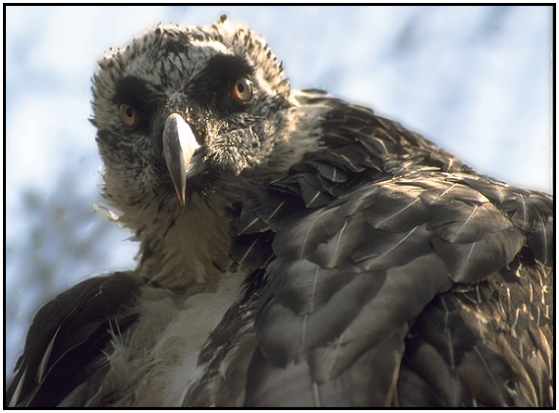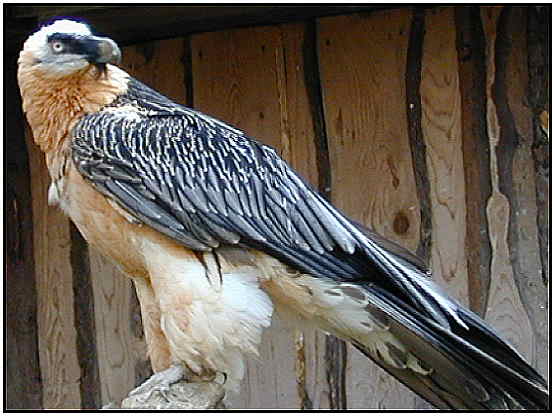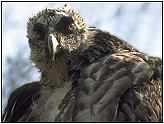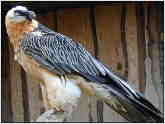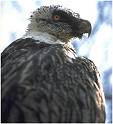BeardedOrder: Falconiformes. Family: Accipitridae. (Old World vulture). Scientific Name: Gypaetus barbatus. Common Names: Bearded Vulture, Lamb Vulture, Lammergeier, Lammergeyer or Lammergeir. (All names, with the exception of the first one, are being phased out since the bird is quite harmless and incapable of killing lambs). Conservation Status: Endangered. Exact population numbers are unknown. Birds of prey have long been seen as a threat; in the case of the Bearded Vulture it has been accused of attacking lambs, chamois, and even children. Though none of these is correct the locals hunted this bird until it was close to extinction. This was mainly done through leaving poisoned carcasses lying in the open. The present tiny Bearded Vulture population now also battles the problem of inbreeding and lack of genetic diversity; this exists in both the captive and wild birds. Rescue & Recovery: A programme of recovery for the Bearded Vulture is based at the Austrian Alpine Zoo in Innsbruck, and run by the World Wildlife Fund. Multiplication of chicks has been greatly increased by removing younger eggs that would usually be killed by older chicks in an act of cannibalism. These chicks are then hand-raised, but may be returned to their parents when they're big enough to fend for themselves. About three weeks before they are ready to take flight the young birds are taken to a ledge high in the Alps, from here they will learn to fly and search for their own food. This programme has been a great success and since 1986 more than sixty captive birds have been released. So far this programme has proven to be a good success with only one or two birds dying. By the 21st century it is hoped a viable breeding population will have been re-established.
Bearded Vulture (Photograph Courtesy of Jan Branje Copyright ©2000)Geographical Range: Limited numbers found in parts of central Asia and in North Africa. (Some occurrences in the eastern and southern areas). European populations have plummeted with only 40-50 pairs nesting and the species being very localised in Spain and Greece. A few individuals and pairs still survive in Corsica, Crete, Rhodes and Sardinia. Habitat: Lives in high mountainous regions, descending down to arid lowlands to feed. Physical Characteristics: This is a spectacular bird averaging around 108 centimetres long and with a three-metre wingspan. Mature Bearded Vultures have blackish grey feathers on their back, wings and tail. The middle of the feathers varies from a pinkish colour to off-white. In the wild the underparts of Bearded Vultures are a rusty brown, but captive birds tend to be white. This is because wild birds preen themselves with the iron oxide deposits which occur naturally around areas where they nest. This serves two purposes, killing fleas and protecting damaged feathers. The disadvantage is that coated feathers are less windproof, so the coating is only applied to outer feathers, leaving the others to provide warmth. Around the eye is a group of stiff black feathers which descends down to form a 'beard' just below the very powerful bill. Young birds are of a uniform brown colouring and take five to six years to reach maturity. Particularly graceful bird which spends most of the day on the wing. Food: When gathering around a carcass the Bearded Vulture is rarely dominant and must wait until other species are gorged. This bird has a feathered head since it does not dip deep into the gory carcass and has to make do with just the leftovers. As a result, this carrion feeder has developed the specialty of breaking bones, with a preference being given to larger bones. Picking dinner up in its feet, it gains power from a long falling swoop and then cracks the bone against a passing rock; up to thirty repeats of this action may be required before a bone breaks. This same style may also be used to prepare tortoises for eating. Captive reared Bearded Vultures still use this technique and show no signs of having lost any of their talents.
Bearded Vulture (Photograph Courtesy of Erich Mangl Copyright ©2000)Once the bone has shattered, the Bearded Vulture uses its specially adapted long thin trowel-like tongue to eat the marrow. Interestingly, this bird's tongue is shaped exactly like the marrow scoops used in fine homes last century, a time when marrow was considered a great delicacy. Smaller fragments of bone are eaten whole despite the sharp edges. As part of the rescue programme for this species nice wholesome carcasses are put out for them to feed off. The Bearded Vulture is also assisted by avalanches which often trap entire herds of chamois, to be revealed again when the thaw comes. Favours the afterbirth of sheep. There are repeated reports of this bird trying to force people or animals over cliffs, but it is unknown how much truth there is in this. Reproduction: Breeding is preceded by a diving and swooping display. Once paired off Bearded Vultures hold a very large territory of around 400 square kilometres, an area they will defend vigorously against their own species. They nest among a hollow or crack in high cliffs, usually laying only one egg, though sometimes two may be produced. In the latter case it is likely only one chick will be successfully raised with the other being killed by the older chick. Incubation falls to the female and takes about 53 days. Both parents provide food for the young and after 107-117 days it takes flight. Other: The ancient Greek playwright Aechylus died suddenly when a tortoise fell on his bald head. Though naturalist Pliny wrote it was dropped by an eagle this was thought to be a myth until someone sighted a Bearded Vulture dropping a tortoise from height onto rocks. These birds kill and open tortoises using this method and it is now thought a Bearded Vulture mistook the writer's head for a rock. Thumbnails (Click For Full-Size Image):
|

